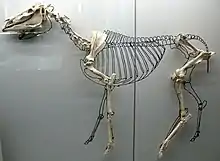| Hipparionini Temporal range: | |
|---|---|
 | |
| Scientific classification | |
| Domain: | Eukaryota |
| Kingdom: | Animalia |
| Phylum: | Chordata |
| Class: | Mammalia |
| Order: | Perissodactyla |
| Family: | Equidae |
| Subfamily: | Equinae |
| Tribe: | †Hipparionini Quinn, 1955 |
| Genera | |
|
See text | |
Hipparionini is a tribe of three toed horses in the subfamily Equinae. They had body forms similar to modern equines, with high-crowned teeth. They first appeared in North America during the Early Miocene around 17 million years ago, before migrating into the Old World around 11-10 million years ago.[1] The youngest species date to the Early Pleistocene.[2]
Taxonomy
North American genera:
- "Hipparion" [1] (distinct from Old World species assigned to this genus)
- Neohipparion
- Pseudhipparion
- Nannippus
- Cormohipparion
Old World genera:[1]
- Hipparion sensu stricto
- Hippotherium
- Cremohipparion
- Sivalhippus
- Eurygnathohippus
- Plesiohipparion
- Proboscidipparion
- Shanxihippus
References
- 1 2 3 Janis, Christine M.; Bernor, Raymond L. (2019-04-12). "The Evolution of Equid Monodactyly: A Review Including a New Hypothesis". Frontiers in Ecology and Evolution. 7. doi:10.3389/fevo.2019.00119. hdl:1983/ede09e37-96f7-4baf-aec5-1bb7766a04e7. ISSN 2296-701X.
- ↑ Cirilli, Omar; Pandolfi, Luca; Alba, David M.; Madurell-Malapeira, Joan; Bukhsianidze, Maia; Kordos, Laszlo; Lordkipanidze, David; Rook, Lorenzo; Bernor, Raymond L. (April 2023). "The last Plio-Pleistocene hipparions of Western Eurasia. A review with remarks on their taxonomy, paleobiogeography and evolution". Quaternary Science Reviews. 306: 107976. doi:10.1016/j.quascirev.2023.107976. S2CID 257594449.
This article is issued from Wikipedia. The text is licensed under Creative Commons - Attribution - Sharealike. Additional terms may apply for the media files.